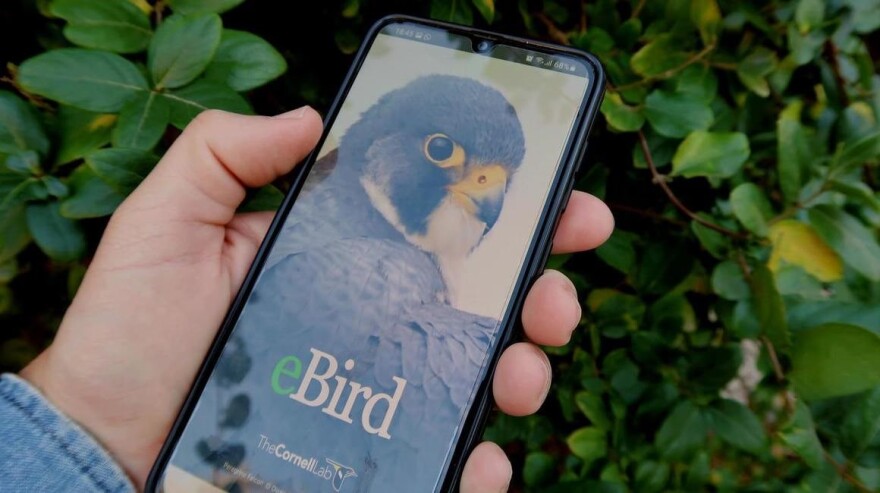This story was first published in KCUR's Adventure newsletter. You can sign up to receive stories like this in your inbox every Tuesday.
Interest in birding has spiked in the last few years. The activity has an easy point of entry but can transform into a lifelong passion. It’s also a hobby that welcomes a wide spectrum of participants, who can casually enjoy watching birds or zealously pursue their targets.
The only thing birding requires (after birds, obviously) is stillness and observation. Charming, curious and sometimes aggressive birds offer a glimpse into a world that operates from a completely different perspective and mindset than ours.
Birding also tunes the birder to the environment, connecting them closely to the weather, the seasons and the time of day, as well as the song, sight and movement of the birds.
Reclaim that connection with nature. There are plenty of places and resources for the beginning or experienced birder, including field guides, websites and clubs. Check out our previous avian adventure and read on to learn how you can connect with our feathered friends.
Backyard bird watch
Take part in The Great Backyard Bird Count, which runs this year from Feb. 14 to 17, 2025. It’s a great excuse to spend some time outdoors (though, if you have strategically placed bird feeders, you can participate from the comfort of your window seat) while taking part in a global initiative.
GBBC has been in action for 25 years, but if you’ve never participated or even birded before, watch the webinar and check out the suggested Merlin Bird ID app, through The Cornell Lab of Ornithology. eBird (also from Cornell) is another popular app to help you identify and record the birds you see.
Record your observations and submit your findings to help capture (metaphorically, of course!) bird populations around the globe. If you don’t have a backyard, you could observe from another accessible space, such as a nearby city park.
Each year, KC Parks invites people to the Trailside Center on Holmes Road to participate in the Great Backyard Bird Count during a one-mile hike along Indian Creek Trail, led by a volunteer from Missouri Master Naturalists. Stay tuned for dates.
As you get to know your local birds, the visitors will stand out. Many birders keep lists of birds they observe. According to the U.S. Fish & Wildlife Services, there are approximately 500 species of birds that live or visit the Midwest — comprising just 5% of the estimated 10,000 species worldwide.
Another important counting day is Global Big Day, which coincides with World Migratory Bird Day. Last year, GBD broke records for both participants and bird observations. This year it occurs on Sunday, May 4.

Urban birding
Just because you might be stuck in the city doesn’t mean you’re bereft of birds. While most birds prefer wilder spaces, many have adapted to human-shaped environments and made them their own.
Rock pigeons, robins and crows are ubiquitous and easy to identify. Peregrine falcons found respite in the crevices of skyscrapers. Cliff swallows build mud nests under bridges. Canada geese will sometimes stop traffic near Brush Creek, red-tailed hawks are often seen riding the updraft over the UMKC Volker campus and turkey vultures frequent the skies above highways.
Though starlings are considered nuisance birds, there’s no denying the mysterious beauty of a murmuration, seeming to float and shift against the city skyline. In reality, the flock is trying to evade a predator, but it’s still a sight to behold. See this video taken near the River Market.
Maybe it’s cheating, but you don’t have to travel to Antarctica to add penguins to your list. Join the Kansas City Zoo for their Penguin March every weekend throughout the year. You can also observe the penguins pretty much anytime via the KC Zoo Penguin Cam. (If you check in during the night, you’ll see them sleeping, which is legitimately cute.)

Into the wild
If you wish to see a wide variety of birds, you’ll get to journey to different biome: wetlands, grassland, forests and more. Devoted birders travel the globe, but there’s plenty of variety close to home, especially with Kansas City situated along the migratory path for many species.
Between March 1 and June 1 in the spring, and Aug. 1 to Nov. 15 in the fall, check out BirdCast to see which migratory birds are traveling through the region.
Not sure where to start? KC Birding Walks shares likely birding locations, organized by region, and some of the types of birds you might see in that area.
Within an hour or so of the city, nature preserves, conservations, and wildlife refuges provide safe environments for birds to rest and refuel, including Marais des Cygnes National Wildlife Refuge (south of Louisburg, Kansas), the Baker Wetlands (Lawrence, Kansas), Green Hills of Platte Wildlife Preserve (Parkville, Missouri), Smithville Lake (Smithville, Missouri), and Loess Bluffs National Wildlife Refuge (north of St. Joseph, Missouri).
Some locations, such as Marais des Cygnes, provide checklists for the types of birds known to frequent their acres, what time of year to see them and how common or rare they are — including the Great Blue Heron, Giant Egret, as well as a variety of warblers, woodpeckers and more.

Positive environment
Unfortunately, many bird species are threatened, primarily due to human encroachment. According to the American Bird Conservancy, one of the leading conservation groups, 11 bird species were added to the extinction list in 2021 by the USFWS, and nearly three billion birds have been lost since 1970.
For both local birds and yearly visitors, there are ways to enhance the environment and attract a variety of birds. Join the Missouri River Bird Observatory at the Burr Oak Woods Nature Center in Blue Springs for an in-person class about nesting boxes for American Kestrels.
The Eastern Bluebird is the Missouri state bird, but for decades it was in peril. Mill Creek Streamway, a 17-mile trail in Johnson County, is part of the National Bluebird trail, with over 60 nesting boxes. From Nelson Island, at the northern end of the trail, you can also spot bald eagles fishing in the Kansas River during the winter.
Lakeside Nature Center, in Swope Park, rehabilitates injured animals and has a variety of birds on display that can’t be released back into the wild. They also have instructions for encouraging and protecting chimney swifts, should you be so lucky to have their nest in your chimney.
You can also help the birds who are just passing through on their arduous migrations. The National Wildlife Federation shares the top 10 tips from the American Bird Conservancy. There’s also a push to reduce light pollution in cities, which disorients nighttime migrators.

Flock together
Birding is often a solo endeavor, but the best way to learn is to join experienced birders in the field. Local birding clubs host field trips to locations around the metro, many of which are free to attend. Stores dedicated to bird supplies can help with field guides and feeder supplies. There are also online communities, which allow people to share their pictures of birds, get help identifying an uncommon bird and also help alert folks to rare birds in the area.
This winter, birders spotted Snowy Owls in the area, in a rare irruption far south from their Arctic climate, though unfortunately, those sightings are becoming more frequent as climate change alters their habitat.
In early March 2021, the Facebook group Kansas Birding alerted members to a blue heron rookery — with 12 nests — along Indian Creek Parkway in Overland Park. Organizations include the Burroughs Audubon Society of Greater Kansas City, Kansas Ornithological Society, Jayhawk Audubon, and Missouri River Bird Observatory. Burroughs also houses a nature library that is free to visitors for in-house use of the collection.
There are plenty of tips on beginning birding, but before you buy an expensive pair of binoculars, spend hours studying a field guide, or download an app, there’s a simpler way to start.
Get outside. Sit quietly. Listen to the birds and try to distinguish different calls. Pick just one or two birds in view and study their markings and mannerisms.
The more you get to know the birds in your neighborhood, the easier it will be to expand that knowledge as you continue your birding journey.
Want more adventures like this? Sign up for KCUR's Adventure Email.









